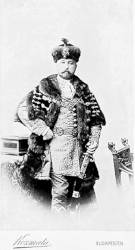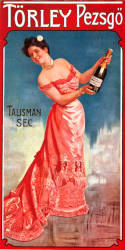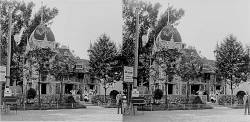Törley Pezsgőmanufaktúra
Useful Information


| Location: |
Budapest, 1221 Anna utca 7.
(47.430455, 19.035540) |
| Open: |
On certain days throughout the year. For groups after reservation. [2022] |
| Fee: |
Adults HUF 6,300. [2022] |
| Classification: |
 Cellar Cellar
|
| Light: |
 Incandescent Incandescent
|
| Dimension: | T=12-14 °C. |
| Guided tours: | MinAge=18. |
| Photography: | |
| Accessibility: | |
| Bibliography: | |
| Address: |
Budapest, 1221 Anna utca 7, TeL: +36-1-229-2300.
E-mail: |
| As far as we know this information was accurate when it was published (see years in brackets), but may have changed since then. Please check rates and details directly with the companies in question if you need more recent info. |
|
History
| 01-AUG-1882 | József Törley és Társa cég founded at 578 Péter-Pál utca. |
| 1885 | gold medal of the National General Exhibition in Budapest. |
| 1890 | relocated to Anna Street, where Törley established a 20,000 m² cellar. |
| 1893 | gold medal of the National Industrial Association. |
| 1896 | Törley Pavilion one of the notable attractions of the World Expo in Budapest. |
| 1896 | given the title of Csantavér and Hungarian nobility by Austrian Emperor Franz Joseph I, King of Hungary and Bohemia. |
| 1898-1899 | largest champagne factory of the Austro-Hungarian Empire. |
| 1905 | production reaches one million bottles. |
| 1907 | József Törley dies on holiday in Oostende, Belgium. |
| JUL-1944 | hit by a bomb during World War II. |
| 1949 | nationalized by the communist government. |
| 1951 | production resumed, Törley the only champagne factory in Hungary under supervision of Unicum Likőrgyá. |
| 1992 | bought by the German Henkell investor group. |
| 03-JAN-2005 | Törley Pezsgőpincészet Kft. founded. |
Description

Törley Pezsgőmanufaktúra (Törley Sparkling Wine Manufacture) is - as the name says - a factory where sparkling wine is produced. This is done using two traditional methods, which requires a lot of manual work, hence the Manufacture in the name. The company is conveniently located in the Capital Budapest and has vast cellars which are definitely worth a visit. Unfortunately there are no regular tours of the cellars. It’s possible for groups to make a reservation, but for individual tourists there are only a few days throughout the year, where they can take a tour. As far as we understood in May and in October, but its definitely mandatory to register by email, where you might also get additional info.
Törley currently produces sparkling wine using two methods. The first was called méthode Chmpagnoise, because it is the original method invented in the Champagne in France, before this name was trademarked and everybody using it is sued to ruin. It is now called méthode traditionelle, the official EU designation is classic method (méthode classique). It uses bottles for the second fermentation which produces the sparkles. The second is called Charmat process and uses large vats for the second fermentation. It was invented by the Italian Federico Martinotti in 1895 and further developed by Eugène Charmat in 1907.
The visit to the wine cellars takes two hours. It includes the cellar, where the sparkling wine is produced and stored, and the museum. There is also a wine tasting afterwards, depending on the number of tasted wines the tour may take between 1.5 and 2.5 hours. The tours are held in Hungarian, guides in other languages are available for an additional fee. Minors are not allowed on the tours.
The winery is located downstream from the city center of Budapest. In this area the Danube flows southwards, and the winery is for obvious reasons located on the western, hilly side, the Buda side. The suburb Budafok is located on a low limestone hill, which is about 40 to 80 m higher than the Danube. There is a narrow plain along the river, where the factory is located, only 600 m from the river. Right behind the factory the hill rises with a 40 m high escarpment, an obvious location to build cellars horizontally into the rock. They have the great advantage, that it is possible to transport the wine in and out using carts.
The company was founded by József Ernő Félix Törley Csantavéri (*1858-✝1907), or József Törley. His father was named Valentin Schmierl. After he took part in the struggles of the 1848-49 Revolution and War of Independence, he changed his name to Bálint Törley. This is a rather creative translation of his name into Hungarian. Valentin to Bálint, is quite obvious, but the German name Schmierl contains the verb schmieren which means to smear, and he interpreted it as overwrite or delete which is törlés in Hungarian. József Törley studied at the Academy of Trade in Graz, Austria, where he met the French champagne manufacturer Teophilus Roederer. He learned champagne production in Reims, while he was employed by Louis Roederer and later by Delbeck et Cie.. He opened his own champagne factory in Reims. When he went to Hungary to buy wine, he discovered Budafok, which was named Promontorra at that time, and realized that it was suitable for the production of champagne. He bought vineyards, a house and a press house and in 1882 he relocated his Reims factory here.
In 1890, the factory moved to Anna Street, where Törley established a 20,000 m² cellar. It was continually extended and reached a total length of 72 km. The quarried limestone went into the construction of Hungary’s Parliament which was the largest building on earth when it was completed in 1904.
Törley was a very successful businessman. He had the most modern machines, introduced refrigerative disgorging in Hungary, was the first to buy trucks for the fastest and safest transport of goods and became a founding member of the Royal Hungarian Automobile Club. He also recognized the importance of good advertising. He won the gold medal of the National General Exhibition in Budapest 1885 and the Törley Pavilion was a notable attraction of the World Expo in Budapest 1896. Törley died unexpectedly during a vacation in Oostende, Belgium, due to appendicitis perforation at the age of 49. As he had no children the factory was inherited by the sons of his brother who successfully continued in the same style. But World War I and the Great Depression were a huge setback.
During World War II the factory was hit by a bomb in 1944 and mostly destroyed, after the war it was restarted with only four people selling the already produced bottles from the cellar. But in 1949 it was nationalized, during the Cold War it was owned by the government and managed by the Unicum Likőrgyár (Unicum Liqueur Factory). The demand increased, and it was possible to export champagne for foreign currency, so the factory developed to 30 million bottles per year by the end of the 1980s. At the end of the Cold War communism was abandoned and the company had to adapt to a completely different situation. The German Henkell investor group bought the winery. The Törley Pezsgőpincészet Kft. (Törley Sparkling Wine Cellar Ltd.) was founded in 2005 and is still a subsidiary of Henkell.
The adjacent Törley Kastélyban (Törley Castle) was built by the architect Ray Rezső Jr between 1890 and 1904. Such chateaus were built by many rich industrialists in this era. It was the home of the Törley family until the end of World War II. Then it was temporarily used by the Hungarian National Guard, when they abandoned it, it was looted and vandalized. In 1957 the Radiobiology Research Institute was established in the building, and it uses the building until today. It is today named National "Frédéric Joliot-Curie" Research Institute for Radiobiology and Radiation Health. The building is not open to the public.
- See also
 Search DuckDuckGo for "Törley Pezsgőmanufaktúra"
Search DuckDuckGo for "Törley Pezsgőmanufaktúra" Google Earth Placemark
Google Earth Placemark Törley - Wikipedia (visited: 29-DEC-2022)
Törley - Wikipedia (visited: 29-DEC-2022) József Törley - Wikipedia (visited: 29-DEC-2022)
József Törley - Wikipedia (visited: 29-DEC-2022) Törley-kastély (Budapest)
Törley-kastély (Budapest)  - Wikipedia (visited: 29-DEC-2022)
- Wikipedia (visited: 29-DEC-2022) Törley Sparkling Wine Manufacture, official website (visited: 29-DEC-2022)
Törley Sparkling Wine Manufacture, official website (visited: 29-DEC-2022) Törley-kastély
Törley-kastély  (visited: 29-DEC-2022)
(visited: 29-DEC-2022)
 Index
Index Topics
Topics Hierarchical
Hierarchical Countries
Countries Maps
Maps